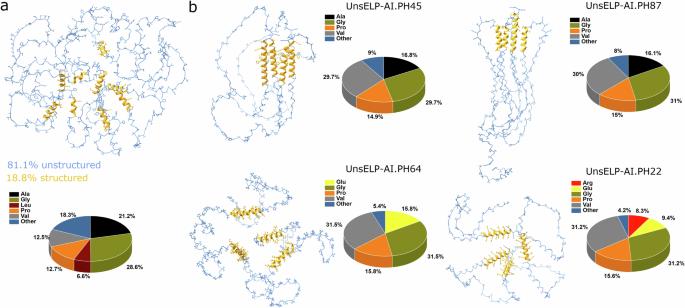Material engineering and application of hybrid biomimetic-de novo designed elastin-like polypeptides
IF 7.5
Q1 MATERIALS SCIENCE, MULTIDISCIPLINARY
引用次数: 0
Abstract
The global concern over environmental consequences of petrochemical-derived plastics underscores the urgent need for sustainable and biodegradable polymers. In this context, elastin-like polypeptides emerge as a promising solution, offering multiple advantages, including remarkable mechanical properties, biocompatibility, customizable functionalities, and renewable sourcing through biosynthetic production in microbes, making them a compelling choice for various applications. We previously demonstrated accelerated engineering of a new class of elastin-like polypeptide‐based materials through hybrid biomimetic‐de novo predictive molecular design. The resulting variants exhibited enhanced molecular stability compared to their natural counterparts, catering to a range of technical applications that involve harsh downstream processing conditions. Here, we showcase the use of some of these previously discovered hybrid variants and illustrate the effective translation of the predicted molecular designs in structural and functional materials in several high-added-value applications. This includes multiscale drug-encapsulating vehicles with controlled release, multifunctional wound coverings, and all-aqueous-based biobased photoresists for creating 2D/3D microstructures. Elastin-like polypeptides are polymers with properties that make them suitable for medical and industrial applications. Here, predicted biomimetic-de novo elastin-like polypeptide variants are demonstrated for drug-encapsulating vehicles, multifunctional wound coverings, and biobased photoresistors applications.

混合仿生-全新设计弹性蛋白样多肽的材料工程与应用
全球都在关注石化塑料对环境造成的影响,这凸显了对可持续和生物降解聚合物的迫切需求。在此背景下,弹性蛋白样多肽成为一种前景广阔的解决方案,它具有多种优势,包括显著的机械性能、生物相容性、可定制的功能性,以及通过微生物生物合成生产的可再生来源,使其成为各种应用的理想选择。此前,我们通过混合仿生-从头开始的预测性分子设计,展示了一类新型弹性蛋白样多肽基材料的加速工程设计。与天然对应物相比,由此产生的变体具有更高的分子稳定性,可满足一系列涉及苛刻下游加工条件的技术应用。在此,我们展示了其中一些先前发现的混合变体的使用情况,并说明了预测分子设计在结构和功能材料中的有效应用。这包括具有控释功能的多尺度药物封装载体、多功能伤口覆盖物以及用于创建二维/三维微结构的全水基生物光刻胶。弹性蛋白样多肽是一种聚合物,其特性使其适用于医疗和工业应用。在此,我们展示了预测的生物仿生-新生弹性蛋白样多肽变体,可用于药物封装载体、多功能伤口覆盖物和生物基光阻应用。
本文章由计算机程序翻译,如有差异,请以英文原文为准。
求助全文
约1分钟内获得全文
求助全文
来源期刊

Communications Materials
MATERIALS SCIENCE, MULTIDISCIPLINARY-
CiteScore
12.10
自引率
1.30%
发文量
85
审稿时长
17 weeks
期刊介绍:
Communications Materials, a selective open access journal within Nature Portfolio, is dedicated to publishing top-tier research, reviews, and commentary across all facets of materials science. The journal showcases significant advancements in specialized research areas, encompassing both fundamental and applied studies. Serving as an open access option for materials sciences, Communications Materials applies less stringent criteria for impact and significance compared to Nature-branded journals, including Nature Communications.
 求助内容:
求助内容: 应助结果提醒方式:
应助结果提醒方式:


